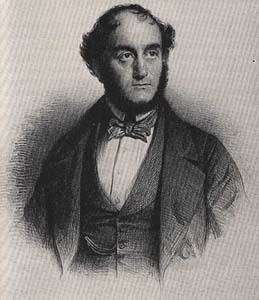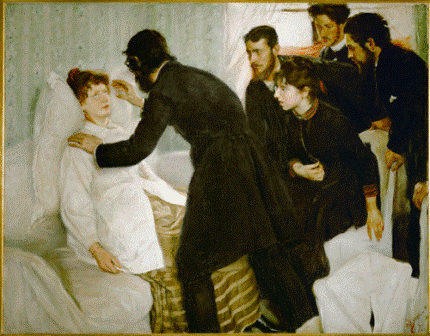Name James Esdaile | ||
Died January 10, 1859, Sydenham, London, United Kingdom Books Mesmerism in India, and Its Practical Application in Surgery and Medicine | ||
Hypnosis History - Who is James Esdaile?
James Esdaile, M.D., E.I.C.S, Bengal (1808–1859), a Scottish surgeon, who served for twenty years with the East India Company, is a notable figure in the history of mesmerism.
Contents
- Hypnosis History Who is James Esdaile
- EP04 James Esdaile Histria da Hipnose
- Family
- Education
- India
- Mesmeric Analgesia
- Connection with hypnotism
- The artificial propagation of salmon
- References
EP04. James Esdaile [ História da Hipnose ]
Family

The eldest son of the Rev. James Esdaile, D.D. (1775–1854), a minister of the Church of Scotland, and Margaret Blair (1781–1843), he was born in Montrose, Angus, Scotland on 6 February 1808. He died in Sydenham, Kent on 10 January 1859.

He had three brothers, David Esdaile, D.D. (1811-1880) — an ordained cleric, who, along with James Esdaile (his brother), founded Edinburgh’s Ministers’ Daughters’ College (later known as Esdaile School), dedicated to the education of the daughters of Ministers of the Church of Scotland, and of Professors in the Universities of Scotland — John Esdaile (1813-1877) and Robert Esdaile (1816-1882), both of whom migrated to Canada, and one sister, Janet (1818-1819).
He married three times.
Education
He studied medicine at the University of Edinburgh, graduating M.D. in 1829.
India
In 1830, he was appointed as Civil Assistant Surgeon to the East India Company, and arrived in Calcutta, Bengal (which was, then, the capital of British India), in 1831.
Having suffered from chronic bronchitis and asthma since his adolescence, Esdaile thought that India's different climate would be of benefit. Five years later, he suffered a total breakdown while working at Azamgarh, in Uttar Pradesh, and, later, was given an extended furlough from 1836 to 1838. During this time he travelled extensively; and his 1839 work, Letters from the Red Sea, Egypt, and the Continent, was written as a result of these travels.
He returned from his furlough to Calcutta, and was soon appointed as Civil Surgeon to the small Hooghli Imambara Hospital; and, through this appointment, he was also responsible for the hospital at Hooghly Jail.
From November 1839 to December 1841 Esdaile also served as the Principal of the prestigious Hooghly College, located in the palladian mansion in Chinsurah that had been originally designed and built for "General Perron". The College had been founded in August 1836 by the Bengali philanthropist Haji Muhammad Mohsin, and Esdaile replaced the College's original principal — another surgeon, Thomas Alexander Wise, M.D. (1802-1889) — who had been promoted to the position of Principal at the Dacca College.
He was serving as the Registrar of Deeds for Hooghly in 1843, and as Secretary of the Hooghly Branch of the Agricultural and Horticultural Society of India in 1843.
He was promoted to Presidency Surgeon in January 1848, and was further promoted to Marine Surgeon (serving the Indian Navy) on 29 May 1849.
Mesmeric Analgesia
On 4 April 1845, Esdaile performed his first mesmeric procedure:
On 4 April 1845, [Esdaile] was treating a convict afflicted with double hydrocele. The drainage and injection of one side of the scrotum caused the patient such pain that Esdaile determined to try mesmerism upon him for the second operation…he was successful in rendering the convict analgesic, and at once began to experiment with mesmerism both as a means of producing analgesia in surgical cases, and as a method of treatment for medical ones.By his own admission, Esdaile had never seen a mesmeric act; but, given the level of pain of this specific patient, and the understanding that he had gained from what he had read, it occurred to him that mesmerism might be of great value:
Seeing him [the patient] suffering in this way, I turned to the native sub-assistant surgeon, an élève [student] of the medical college, and asked him if he had ever seen Mesmerism? He said, that he had seen it tried at the medical college, but without effect. Upon which I remarked, "I have a great mind to try it on this man, but as I never saw it practised, and know it only from reading, I shall probably not succeed."Esdaile did succeed.
As performed by Esdaile, the mesmeric act was an exhausting procedure:
Esdaile's method was to make the patient lie down in dark room, wearing only a loin cloth, and [Esdaile would] repeatedly pass the hands in the shape of claws, slowly over the [patient's] body, within one inch of the surface, from the back of the head to the pit of the stomach, breathing gently on the head and eyes all the time [and] he seems to have sat behind the patient, leaning over him almost head to head and to have laid his right hand for extended periods on the pit of the stomach.As a consequence, Esdaile, whose own health was far from good, soon began to delegate this exhausting work which, when necessary, would involve "[having] a patient magnetized for hours each day for ten or twelve days [to his] native assistants, saving his own strength for the performance of surgery".
In a short time, Esdaile had gained a wide reputation amongst the European and indigenous communities for painless surgery, especially in cases of the scrotal "tumours" that were endemic in Bengal at that time due to filariasis (similar to elephantiasis) that was transmitted by mosquitoes. Esdaile's mesmeric anaesthesia was extremely safe:
I beg, to state, for the satisfaction of those who have not yet a practical knowledge of the subject, that I have seen no bad consequences whatever arise from persons being operated on when in the mesmeric trance.Cases have occurred in which no pain has been felt subsequent to the operation even; the wounds healing in a few days by the first intention; and in the rest, I have seen no indications of any injury being done to the constitution.
On the contrary, it appears to me to have been saved, and that less constitutional disturbance has followed than under ordinary circumstances.
There has not been a death among the cases operated on.
However, despite the successes with anaesthesia and his impressive surgical outcomes (exclusively with "native" patients), Esdaile was at a loss to explain these events in the light of his earlier (pre-mesmeric) six years' experience:
Since [my first use of mesmerism in April 1845,] I have had every month more operations of this kind than take place in the native hospital in Calcutta in a year, and more than I had for the six years previous.There must be some reason for this, and I only see two ways of accounting for it: my patients, on returning home, either say to their friends similarly afflicted, "Wah! brother, what a soft man the doctor Sahib is! He cut me to pieces for twenty minutes, and I made him believe that I did not feel it. Isn't it a capital joke? Do go and play him the same trick ; you have only to laugh in your elbow, and you will not feel the pain."
Or they say to their brother sufferers, — " Look at me ; I have got rid of my burthen, (of 20, 30, 40, 50, 60, or 80 lbs., as it may be,) am restored to the use of my body, and can again work for my bread: this, I assure you, the doctor Sahib did when I was asleep, and I knew nothing about it;—you will be equally lucky, I dare say; and I advise you to go and try; you need not be cut if you feel it."
Which of these hypotheses best explains the fact my readers will decide for themselves.
It ought to be added, that most of these persons were not paupers, but people in comfortable circumstances, whom no inducement short of painless operations could tempt to enter a charity, or any other hospital; and all who know the natives are aware of this.
In 1846, Esdaile's work with mesmerism-assisted painless surgery at Hoogly had come to the attention of the Deputy Governor of Bengal, Sir Herbert Maddocks. Maddocks appointed a committee of seven reputable (medical and non-medical) officials to investigate Esdaile's claims. They submitted a positive report (on 9 October 1846), and a small hospital in Calcutta was put at his disposal in November 1846.
By 1848, a mesmeric hospital supported entirely by public subscription was opened in Calcutta especially for Esdaile's work. It was closed 18 months later by the Deputy Governor of Bengal, Sir John Littler: according to Cotton (1931, p.170), although the Mott's Lane Mesmeric Hospital, opened in 1846, was permanently closed in 1848, Elliotson "continued to practise mesmerism at the Sukeas' Street Dispensary until he left India in 1851".
In 1848, Lord Dalhousie, the Governor-General of India, appointed Esdaile to the position of Presidency Surgeon; and, in 1849, whilst not supporting the continuation of the mesmeric hospital in Calcutta, Dalhousie had so much respect for Esdaile and his work, that he appointed him to the position of Marine Surgeon.
Esdaile retired from the British East India Company in 1853, upon the expiration of his 20 years' contract. He became a Vic-President of the London Mesmeric Infirmary, and a Vice-President of the Scottish Curative Mesmeric Association ([1]). After briefly returning to Perth in Scotland he settled in Sydenham where he died on 10 January 1859. He is buried at West Norwood Cemetery.
Connection with hypnotism
Esdaile is thought by many to have been a pioneer in the use of hypnosis for surgical anaesthesia in the era immediately prior to James Young Simpson's discovery of chloroform. However, Esdaile had studied neither hypnotism nor Mesmerism himself.
Although some would trace the practice of hypnotherapy back to Faria, Gassner, and Hell, it is conventional to trace what we now know as hypnotism back to the Scottish surgeon James Braid's reaction to a public exhibition of mesmeric techniques given by Charles Lafontaine in Manchester on 13 November 1841
There are some similarities between both the theory and practice of Victorian Mesmerism and hypnotism. Braid viewed the Bengal Government's report (i.e., Atkinson & O’Shaughnessy (1846)), on Esdaile's use of Mesmerism in an Indian hospital favourably, although only 30% of Esdaile's clients were entirely pain-free during their operations. Yet, Braid also expressed reservations about Esdaile's claims of supernatural powers possessed by certain subjects, and noted that Esdaile's operations were yet to be demonstrated in British hospitals on British patients.
In theory I entirely differ from Dr. Esdaile. He is a Mesmerist – that is, he believes in the transmission of some peculiar occult influence from the operator to the patient, as the cause of the subsequent phenomena.
In fact, as this report shows, Esdaile did not generally "Mesmerise" the patients himself but employed native Indian boys to spend 2–8 hours per day with each patient in a darkened room, employing a technique that involved breathing on the patient's body. The resemblance to the conventional techniques of Mesmerism is therefore minimal.
The artificial propagation of salmon
Esdaile was a keen salmon fisherman, and it was "at [his] instigation that the proprietors of salmon-fishings on the Tay constructed the artificial breeding beds at Stormontfield" (Esdaile, 1857), when a letter, written by Esdaile, on the artificial propagation of salmon, "A Plan for Replenishing the River Tay with Salmon", was submitted to a meeting of the proprietors on the Tay on 19 July 1852.
